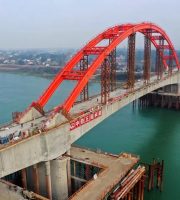Poor pipeline foundation conditions will lead to uneven settlement of pipeline and foundation, generally causing local ponding.
2.
IV Causes of backfill settlement (I): the backfill around the inspection well is not dense, the backfill is not compacted in layers as required, the compaction effect is affected by poor filler quality and poor water content control, resulting in excessive settlement after construction.
The masonry quality of the inspection well shall control the center position and height of the well chamber and wellhead to prevent the well body from deformation.
At this time, the seepage shall be conducted first Mark the leakage one by one and deal with it carefully after draining the water in the main pipe.
2.
In serious cases, pipeline fracture or interface cracking will occur.
For example, miscellaneous sand and gravel are used for backfilling the pits and grooves of drainage facilities under the main road in Nanning.
Carefully do a good job in the base course and cushion of the inspection well, and break the pipe to make a chute to prevent the well body from sinking.
When the geological and hydrological conditions of the foundation are poor, soil replacement and improvement shall be carried out to improve the bearing capacity at the bottom of the foundation trench.
2.
Different tamping tools shall be selected for different fillers and filling thickness to achieve the most economical compaction effect…
(II) preventive measures: 1.
3、 Deformation and sinking of inspection well, Poor quality of components and fittings (I) causes: deformation and subsidence of inspection well, poor quality of well cover and installation, and too random installation of ladder in the well, which affects the appearance and use quality.
Small cracks or pitted surface leakage can be brushed with cement slurry or waterproof coating, and the more serious ones shall be reworked.
(2) if the soil at the bottom of the trench is disturbed or soaked in water, the soft soil layer shall be excavated first, and then the over excavated part shall be backfilled and compacted with stable materials such as miscellaneous sand or gravel.
The practice has proved that the effect is very good.
If necessary, 20cm thick soil layer can be reserved at the bottom of the trench and removed at the same time of excavation during the construction of subsequent processes.
3.
(3) When excavating earthwork below the groundwater level, effective measures shall be taken to prevent drainage and precipitation at the bottom of the trench to ensure the excavation of the dry trench.
6.
The pipeline is leaking, and the closed water test is unqualified (1) Causes: uneven sinking of foundation, poor construction quality of pipe and its interface, untight sealing at the end of closed water section, poor construction quality of well body and other reasons can cause water leakage.
(2) When the trench is narrow, manual or frog rammer can be used for tamping.
The inspection well cover shall be matched with the base; the base slurry shall be full during installation; the light and heavy models and surface and bottom shall be used well, and the iron climbing installation shall be controlled up and down The position deviation of the first step shall not be too large, and the plane position shall be accurate.
(2) Prevention and control measures: 1.
The preventive measures are: (1) The construction shall be carried out carefully according to the design requirements to ensure the strength and stability of the pipeline foundation.
(2) Prevention and control measures: 1.
Preventive measures (1) during pipe trench backfilling, appropriate filler and compaction must be selected according to the backfilling position and construction conditions (tamping) compaction machinery.
The test shall be carried out after treatment and repeated until the closed water is qualified.
Closed water test is a comprehensive inspection of pipeline construction and material quality, during which it is inevitable that three or two unqualified phenomena will occur.
I Pipeline position deviation or ponding (I) causes: measurement errors, construction aliasing and accidental avoidance of original structures, position deviation on the plane, ponding or even downhill on the facade.
(II) prevention and treatment measures: 1.
(2) the construction setting out shall be carried out in combination with the hydrogeological conditions, according to the buried depth, design requirements and relevant regulations, and must be retested and inspected, and the error can be handed over for construction only after it meets the requirements.
Measures to prevent diseases caused by measurement and construction mainly include: (1) Before construction, the handover pile shall be retested and protected carefully in accordance with the construction survey specifications and procedures.
Serious leakage can be handled by professional technicians in addition to replacing pipes and refilling interfaces.
If the structures must be avoided during the construction, a connecting well shall be added at an appropriate position, which shall be connected in a straight line, and the angle of the connecting well shall be greater than 135 °.
(3) The construction shall be carried out in strict accordance with the sample pile, and the axis and longitudinal slope measurement and acceptance of the trench and flat foundation shall be carried out.
The pipe groove is filled from the chest to 30cm from the pipe top, and then filled with water and vibrated to the relative density ≥ 0.7.

